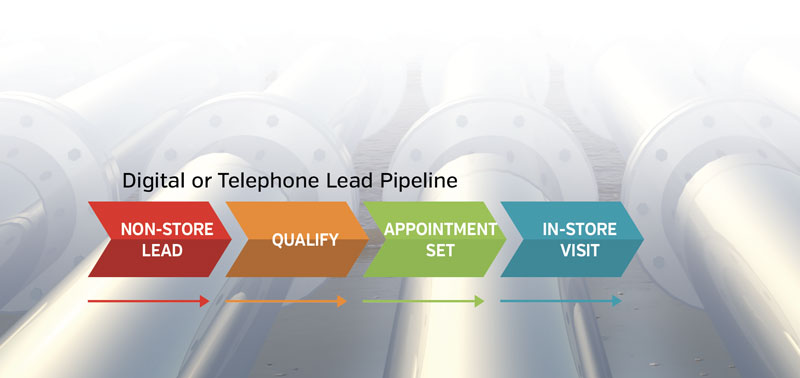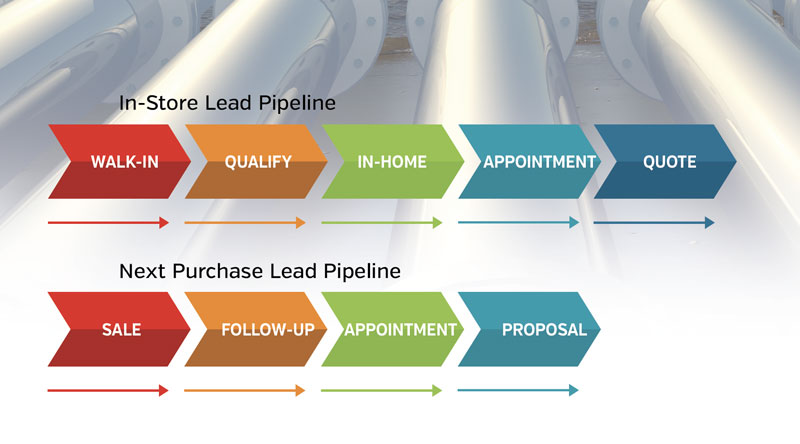Transform Your Business and Sell More
Now that reduced retail traffic and well-informed consumers are the norm, traditional Up systems need to
co-exist with innovative selling pipeline systems and processes.
I recently secretly shopped a competitor of one of my clients. Upon entering the store, I observed a salesperson
finishing up with a prospect. He handed his card to the prospect and said, “Well, when you decide to buy, call
me.” Then he sized me up with a glance. Turning to a few sales associates hanging about, he yelled, “Who’s on
point?” One approached me and asked, “What are you looking for?” I replied, “I’m just looking around because I
am moving here.” After that, I was left to look around until I exited the store.
This experience got me thinking about the number of missed sales this store was giving up due to poor systems
and training.
While other industries use sales pipeline tools to grow sales, true pipelines are poorly understood and rarely
used by furniture retailers. However, those operations that do use pipelines do a better job of capitalizing on
yet-to-be-sold opportunities.
The Process
Sales pipelines guide prospects through defined stages on their way to becoming paying customers. The stronger
the processes in each step, the more likely a prospect will remain in a pipeline. Research affirming that
pipeline selling systems help organizations get control of their revenue streams and produce better results can
be found at https://scholar.google.com (enter the search term “sales pipeline”).
“Sales pipelines guide prospects through defined stages on their way to becoming paying Customers. The stronger
the processes in each step, the more likely a prospect will remain in a pipeline.”
Up Systems Are Not Enough
Most retailers use one type of sales pipeline, referred to as an “ Up system,” which includes the following five
stages:
-
Lead / Welcome / “The Greet”
- Qualifying / Understanding the prospect’s situation
-
Recommending product and service solutions
-
Closing the sale
- Following up after the close.
A BIG and unfortunate problem with most Up systems is that they leak. By this, I mean many more prospects leave
Up system pipelines than become customers. The evidence for this is that win rates (typically known as close
rates) average around 30%. That means that leaky Up systems let 70% of potential customers walk!
A few progressive merchants track the names of the seven out of ten customers who don’t make a purchase, but even
fewer do anything impactful with this information. The central point that I would like Furniture World readers
to understand is that those 70% are not necessarily lost. For example, if an up does not buy right away, but
there is agreed-upon follow-up, they will be moved on to the next pipeline stage: not yet a win, but still a
prospect. No prospect should be “closed out” of the selling pipeline unless:
-
They say “YES” and decide to buy. This is a win!
-
They say “NO,” they are NOT buying. This is a loss.
-
They are UNRESPONSIVE after a specific period or number of follow-ups. This is also a loss.
Fixing the Problem
The downside of most Up systems is that they measure purchases for each visit. In a time of reduced retail
traffic and well-informed consumers, traditional Up systems need to co-exist with innovative selling pipeline
systems and processes.
The good news is that traditional Up systems can work together with selling pipeline systems. Here’s an example:
-
A prospect visits a retail store and is greeted by the next associate in the electronic Up system
rotation.
-
The sales associate performs a proper/professional needs assessment.
-
It becomes apparent that a purchase decision will not be made on the first visit, and that follow-up is
required.
-
The sale is closed in the traditional Up system, with a memo added, “No sale with follow-up.”
-
Information about the prospect and required follow-up details are automatically transferred as an open
opportunity into the digital pipeline system, also known as a Customer Relationship or Experience
Management System. The lead remains open!
-
The potential future value of the prospect, the estimated real close date, the probability of closing,
the lead source, and any important follow-up information are entered with the open opportunity in the
pipeline.
-
Follow-up appointments are made, tracked, and recorded. The opportunity progresses to the next pipeline
stage toward a purchase.
-
When the prospect buys, the opportunity is marked as a win in the sales pipeline. It is simultaneously
marked as a “be-back lead with a sale” in the traditional Up system.

Some of you may be thinking, “Great, now I have to maintain two systems, an Up system and a pipeline
management system.” My response is that you can avoid double entry and retain your traditional retail
metrics using technology. As well, you will gain additional selling tools and actionable pipeline metrics
reporting, such as:
-
Number of customers in the pipeline overall and per associate.
-
The dollar value of the pipeline overall and per associate.
-
The dollar value of the pipeline adjusted by the probability of a close, the estimated close date
overall and by associate.
-
The value of each stage of the pipeline. For example, the qualifying, proposal, appointment, final
quote, or deposit stages.
Follow-up activities: to do, past-due, done, by associate.
-
Deals Won equals Opportunities Won (regardless of how many times they visited you) divided by Total
Opportunities in the date range.
-
Deals Lost equals Opportunities Lost (regardless of how many times a shopper visited you) divided by
Total Opportunities in the date range.
-
Pipeline Closed (for any time period) equals (Deals Won plus Deals Lost) divided by Total
Opportunities in the date range.
-
The time that deals remain in the pipeline overall and by associate.
-
Short- and long-range forecasting with respect to the pipeline overall and by associate.
-
Source and productivity of leads overall and by each associate.
“In this example, a 5% difference in win rate will produce at least $10,000 more in monthly sales for the
salesperson who nurtures the leads in their pipeline.”
Two Salespeople
To illustrate further why sales pipeline tracking is important, consider two salespeople with similar
traditional metrics for one month: 30% close, $2,500 average sale and 80 in-store opportunities. Each
salesperson produces $60,000. So, their performance for the month is identical, right?
Not exactly! That’s because current and future performance depends on each salesperson’s pipeline. If one
salesperson builds their pipeline and closes on more deals in their pipeline, that salesperson will eventually
produce higher win rates and outpace the other salesperson. A 5% difference in win rate will produce at least
$10,000 more in monthly sales for the salesperson who nurtures leads in their pipeline.
Multiple Pipelines
So far, we’ve only discussed the concept of a single in-store sales pipeline. However, most furniture retailers
should have multiple pipelines, each with their own lead sources, marketing, selling process, timelines, deal
sizes, and number of stages required to make a sale. Six pipelines that can warrant separate management and
reporting are:
- Digital Pipeline
- In-store Retail Pipeline
- Next Purchase Pipeline
- Realtor Pipeline
- Commercial Pipeline
- Interior Designer Pipeline

Implementation
A first pipeline stage can often be initiated automatically using integrated technology. A sales associate, or
the technology, then moves prospects through subsequent necessary stages. For instance, not all prospects will
require a house call. Whenever a win (or sale) is achieved, the prospect becomes a customer and exits the
pipeline.
Conclusion
Standard “ Up systems” commonly lead to 70% prospect loss rates. This can be improved by implementing sales
pipeline systems to provide processes and metrics for better organizational management and sales performance.
Even though sales associates would like to close every transaction on a first visit, that’s not a realistic
expectation. We aren’t selling toothpaste! The higher the ticket, the more important it is to measure pipeline
win rates as well as traditional close rates. For those of you who are married, did you or your spouse buy the
ring on a first visit to the jewelry store? I propose the same dynamic is true in home furnishings sales.
Traditional close rates are transactional, whereas pipeline win rates are experiential.
The benefits of embracing sales pipeline systems outweigh the challenges and costs, making it a strategic
imperative for success in an era of informed consumers and evolving retail dynamics.